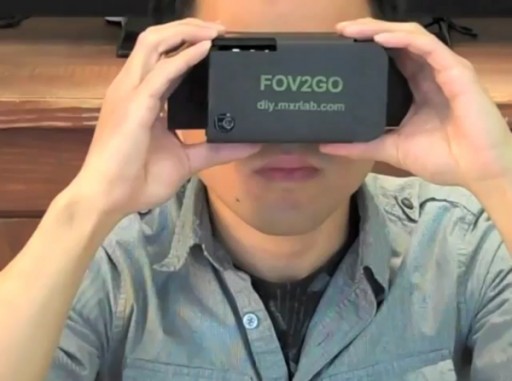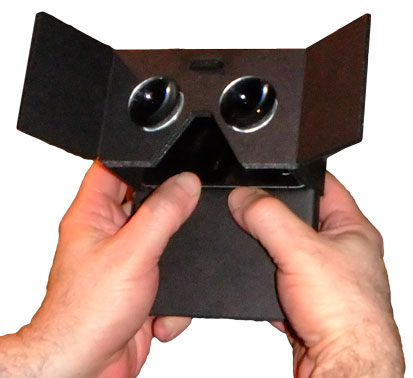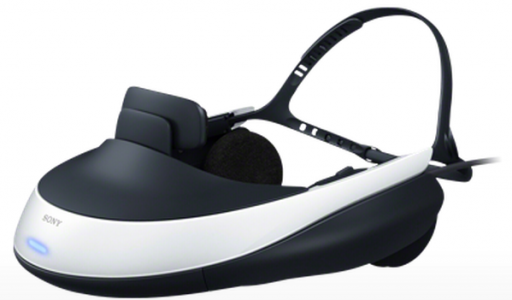Why immersive virtual reality is the next generation of gaming: part 1
July 14, 2012 by James Iliff

FOV2GO (credit: USC/MxR)
It’s now obvious that immersive virtual reality is finally back in the consumer market — with a vengeance.
Especially with the recent advent of FOV2GO, a free DIY portable fold-out iPhone and Android viewer that turns the smartphone screen into a 3-D VR system.
You can create one with foamboard and 2 cheap plastic lenses, and downloadable software lets you create your own virtual worlds or environments to display.

FOV2GO for iPhone (credit: USC/MxR)
(There’s also an iPad3 version.)
What made this possible: high-resolution screens and built-in gyroscopes. The retina display on the iPhone 4, for instance, provides 960×640 DVGA high resolution on a compact screen.
That means we can now construct ultra-lightweight VR head-mounted displays. The gyroscope lets the device track your head movement so you can look around in real time.
FOV2Go is actually a hardware and software kit for the creation of immersive virtual reality experiences using smartphones, tablets, and other mobile devices. More info here.
At the Maker Faire showcase of FOV2GO in May, we showed off a few apps such as Tales from the Minus Lab and Shayd Mobile, both running in the Unity3D game engine with custom C# scripts to create the side-by-side in-game camera.

Harness the power to freely shrink and grow as you explore the uncharted worlds and solve environmental physics puzzles… (credit: USC Games)
I created a Mobile version of the Shayd Virtual Reality installation. While the full installation of Shayd encompasses an entire motion capture stage and wide-FOV head-mounted display, Shayd Mobile is much simpler, utilizing the FOV2GO stereoscopic Unity package developed by Perry Hoberman.
The game could also play on an iPad 3 with very large stereoscopic lenses, allowing for a tasty field-of-view approaching 130 degrees.
Considering that the human eye sees at about 180 degrees, this was pretty realistic! You start out walking around with a flashlight in a dark office, looking for a light switch. Using other inputs on the iPad, you can click on letters on the desk and read them by lantern, or use your flashlight. Eventually you can pull out your gun and fire bullets!
The epicenter for FOV2GO (and other cool projects, including motion capture with the Kinect) is the Mixed Reality Lab (MxR), part of the Institute for Creative Technologies at the University of Southern California (USC).
But there’s something coming that’s even cooler. Much cooler.
People have always been dreaming about virtual reality since Neuromancer and Snow Crash, and in the late 90’s it really captured the public imagination. VR companies were popping up left and right, but the technology wasn’t quite there yet, and the industry crashed and burned around the same time as the dotcom bubble.
Now that it’s experiencing a resurgence fifteen years later, a ton of pseudo-VR devices are coming out that don’t really make any sense.
There’s been a ton of tinkering with controllers, motion devices, stereoscopy, and the like to make gaming a bit more interesting. Microsoft, Sony, and Nintendo have all developed devices that encourage players to get off the couch and into the action. Like the Kinect, the Playstation Move, the Wiimote, the Razer Hydra for PC, and most recently, the Wii U.

Nice try, no cigar (credit: Sony)
Sony, Vuzix, Senics, and NVIZ are all trying to push towards the consumer market, but their HMDs (head-mounted displays) — like the Sony HMZ-T1 and the Vuzix WRAP 920 — are either too expensive or too low-quality, and they have a narrow field-of-view, so you have no sense of peripheral vision.
There’s also no built-in gyroscope or head-tracking, so even if you did play a game with it, you couldn’t move your head around in the virtual environment.
These consumer HMDs feel like a floating television that you are looking at from 5 feet away. So it’s not sparking any real innovation in the games industry, or first-person shooters. Besides, if it looks just like a TV, why not just watch a TV?

Immersive virtual reality hardware
But I found something at the recent E3 Expo 2012 that I’ve been evangelizing since I was a kid. That I know in my heart of hearts is the future — the immediate future — of gaming.
Immersive virtual reality hardware — with real HMDs — has finally arrived. And it’s about to make a huge splash in the first-person shooter hardcore gaming niche.
More in my next post….